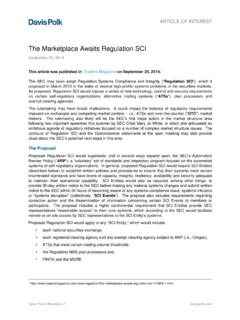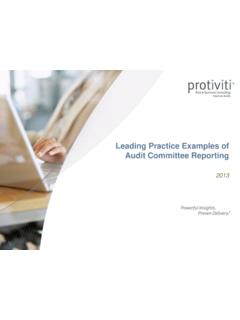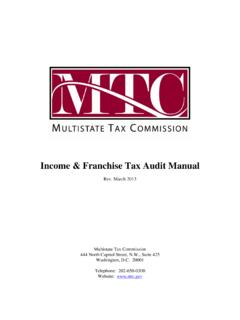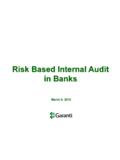Transcription of (Controlled Companies) - Davis Polk & Wardwell LLP
1 Davis Polk & Wardwell LLP Corporate Governance Practices in Initial Public Offerings ( controlled companies ) June 2016 IPO Governance Survey CORPORATE GOVERNANCE PRACTICES IN INITIAL PUBLIC OFFERINGS ( controlled companies ) June 2016 2 Table of Contents Overview 3 The companies 3 Significant Findings 4 Primary Listing Exchange 6 Classes of Outstanding Common Stock 6 Board Size 7 Level of Board Independence 7 Separation of Chairman and CEO 8 Lead Director 8 audit Committee Financial Experts 9 audit Committee Independence 10 Governance/Nominating Committee Independence 11 Compensation Committee Independence 12 Additional Board committees 13 Shareholder Rights Plan (Poison Pill) 13 Blank Check Preferred Stock 14 Classified Board 15 Director Removal for Cause Only 16 Shareholder Ability to Call Special Meeting 17 Advance Notice Bylaws 18 Shareholder Action by Written Consent 19 Board Authority to Change Board Size 20 Board Authority to Fill Vacancies on Board 20 Voting in Uncontested Board Elections 20 Supermajority Vote for Amending the Bylaws 21 Exclusive-Forum Provisions 22 Compensation Consultants 23 New Equity Compensation Plan 24 Employment and Similar Agreements 25 Equity Compensation Awards 26 Disclosure of Non-GAAP Financial Measures 27 Emerging Growth companies 28 Davis Polk s Capital Markets Practice 30 CORPORATE GOVERNANCE PRACTICES IN INITIAL PUBLIC OFFERINGS ( controlled companies ) June 2016 3 Overview As an IPO adviser to companies and underwriters, we surveyed corporate governance practices in recent IPOs to identify current market trends.
2 We focused on the top 50 IPOs of controlled companies (as defined under NYSE or NASDAQ listing standards) and the top 50 IPOs of non- controlled companies , in each case based on deal size from November 1, 2013 through March 31, 2016.* Because controlled companies are exempt from certain NYSE and NASDAQ governance requirements, we examined corporate governance practices at these companies separately from those at non- controlled companies . The survey results below focus on controlled companies , whose deal size ranged from $ million to $ billion. For our survey focusing on non- controlled companies , please see here. The companies We examined the following 50 controlled companies , spanning 34 industries: AMC Entertainment Holdings, Inc. Amplify Snack Brands, Inc. NantKwest, Inc. OM Asset Management plc ARAMARK Holdings Corporation Party City Holdco Inc.
3 Axalta Coating Systems Ltd. Performance Food Group Company Axovant Sciences Ltd. Phibro Animal Health Corporation Black Knight Financial Services, Inc. Planet Fitness, Inc. Blue Buffalo Pet Products, Inc. PRA Health Sciences, Inc. Catalent, Inc. Press Ganey Holdings, Inc. CHC Group Ltd. Rice Energy Inc. Civitas Solutions, Inc. Sabre Corporation Diplomat Pharmacy, Inc. Santander Consumer USA Holdings Inc. Eclipse Resources Corporation ServiceMaster Global Holdings, Inc. EP Energy Corporation Summit Materials, Inc.** First Data Corporation** Surgery Partners, Inc. GoDaddy Inc.** Synchrony Financial** Great Western Bancorp, Inc. TerraForm Global, Inc. Hilton Worldwide Holdings Inc.** TerraForm Power, Inc. Houlihan Lokey, Inc. The Michaels companies , Inc. IMS Health Holdings, Inc. Transocean Partners LLC La Quinta Holdings Inc. TransUnion Match Group, Inc. Univar Inc. Memorial Resource Development Corp. Vince Holding Corp.
4 Virtu Financial, Inc.** Milacron Holdings Corp. Vivint Solar, Inc. Multi Packaging Solutions International Limited VWR Corporation Wayfair Inc. * Excludes foreign private issuers, limited partnerships, REITs, trusts and blank check companies ** Davis Polk participated in the IPO CORPORATE GOVERNANCE PRACTICES IN INITIAL PUBLIC OFFERINGS ( controlled companies ) June 2016 4 Significant Findings Comparing our findings in this survey to those in our 2014, 2011 and 2009 surveys, we found that controlled companies , similar to the non- controlled companies we examined, continued to deploy various takeover defenses in advance of their IPOs, despite the fact that governance advocates (and activist investors) have shown a pronounced dislike for what they view as management-entrenchment devices. For example: 96% of companies adopted a plurality vote standard for uncontested director elections.
5 84% of companies effectively prohibited shareholder action by written consent. 80% of companies had provisions prohibiting shareholders from calling a special meeting. 78% of companies required a supermajority shareholder vote for amending the bylaws. 76% of companies adopted a classified board. We also found that the number of controlled companies that adopted exclusive-forum provisions (another governance attribute disfavored by shareholder advocates) more than tripled over the past several years, from 25% in the 2011 survey to 80% in the 2014 survey to 88% in the 2016 survey, in all likelihood reflecting developments in the Delaware General Corporation Law. In addition, while a higher proportion of controlled companies separated the roles of chairman and CEO relative to non- controlled companies (68% of controlled companies versus 56% of non- controlled companies ), this separation has been on the rise in recent years among all companies , and in the case of controlled companies increased from 40% in the 2009 survey.
6 Other key differences we noted in comparing corporate governance practices at controlled companies to those at non- controlled companies were significantly lower levels of board and committee independence at IPO time (unsurprising in light of the exemption for controlled companies from majority board independence and the independence requirements relating to governance/nominating and compensation committees ). These differences include: The average level of director independence at controlled companies was 41% versus 73% at non- controlled companies . 36% of controlled companies had fully independent audit committees at the IPO versus 88% of non- controlled companies . 18% of controlled companies had fully independent governance/nominating committees at the IPO versus 90% of non- controlled companies .
7 21% of controlled companies had fully independent compensation committees at the IPO versus 88% of non- controlled companies . 20% of controlled companies had an independent chairman versus 32% of non- controlled companies . CORPORATE GOVERNANCE PRACTICES IN INITIAL PUBLIC OFFERINGS ( controlled companies ) June 2016 5 3% of controlled companies without an independent chairman had a lead director versus 44% of non- controlled companies . 76% of controlled companies had a classified board versus 90% of non- controlled companies . 74% of controlled companies were listed on the NYSE versus 58% of non- controlled companies . CORPORATE GOVERNANCE PRACTICES IN INITIAL PUBLIC OFFERINGS ( controlled companies ) June 2016 6 Primary Listing Exchange Of 50 companies examined: 37 companies (74%) listed on the NYSE 13 companies (26%) listed on the NASDAQ Primary Listing Exchange Classes of Outstanding Common Stock Of 50 companies examined: 35 companies (70%) had one class of common stock outstanding 12 companies had two classes of common stock outstanding, 9 (18%) of which had unequal voting rights 3 companies (6%) had three or more classes of common stock outstanding with unequal voting rights Classes of Outstanding Common Stock CORPORATE GOVERNANCE PRACTICES IN INITIAL PUBLIC OFFERINGS ( controlled companies ) June 2016 7 Board Size Of 50 companies examined.
8 The average board size was 8 members The median board size was 8 members Board size ranged from 3 to 11 members There was no distinct correlation between deal size and board size. Deal Size vs. Board Size Level of Board Independence Of 50 companies examined: The average level of director independence was 41% of the board The median level of director independence was 35% of the board The level of director independence ranged from a low of 9% to a high of 91% controlled companies are exempt from majority of independent directors requirement controlled companies are subject to an exemption from NYSE and NASDAQ standards requiring that the board of a listed company consist of a majority of independent directors within one year of the listing date. Deal Size ($ millions) Board Size CORPORATE GOVERNANCE PRACTICES IN INITIAL PUBLIC OFFERINGS ( controlled companies ) June 2016 8 Separation of Chairman and CEO Of 50 companies examined: 34 companies (68%) had a separate chairman and CEO 10 companies (20%) had an independent chairman Separation of Chairman & CEO Independent Chairman Lead Director Of 50 companies examined: 40 companies (80%) combined the roles of chairman and CEO or otherwise did not have an independent chairman Of these, 1 company (3%) had a lead director Independent Chairman Lead Director CORPORATE GOVERNANCE PRACTICES IN INITIAL PUBLIC OFFERINGS ( controlled companies ) June 2016 9 audit Committee Financial Experts Of 50 companies examined.
9 34 companies (68%) had one financial expert 2 companies (4%) had two financial experts 6 companies (12%) had three financial experts 1 company (2%) had four financial experts 7 companies (14%) did not disclose a financial expert Number of audit Committee Financial Experts audit committee financial expert The SEC requires a reporting company to disclose in its annual report (but not in its IPO prospectus) that the board has determined it has at least one audit committee financial expert, or explain why it does not. An audit committee financial expert is a person who has the following attributes: (1) an understanding of generally accepted accounting principles and financial statements; (2) the ability to assess the general application of such principles in connection with the accounting for estimates, accruals and reserves; (3) experience preparing, auditing, analyzing or evaluating financial statements that present a breadth and level of complexity of accounting issues that are generally comparable to the breadth and complexity of issues that can reasonably be expected to be raised by the company s financial statements, or experience actively supervising one or more persons engaged in such activities; (4) an understanding of internal control over financial reporting; and (5) an understanding of audit committee functions.
10 CORPORATE GOVERNANCE PRACTICES IN INITIAL PUBLIC OFFERINGS ( controlled companies ) June 2016 10 audit Committee Independence Of 50 companies examined: 18 companies (36%) had a fully independent audit committee 1 company (2%) had a 3/4 independent audit committee 18 companies (36%) had a 3/5 - 2/3 independent audit committee 13 companies (26%) had a 1/8 - 1/2 independent audit committee audit Committee Independence audit committee independence Under NYSE and NASDAQ rules, an IPO company (including a controlled company) must have at least one independent audit committee member at the time of listing, at least a majority of independent members within 90 days of the effective date of its registration statement and a fully independent committee within one year of the effective date of its registration statement. In addition to the NYSE/NASDAQ independence standards applicable to all independent directors, audit committee members are required to meet additional independence tests set forth by the SEC, which provide that a director who serves on the company s audit committee may not (other than in his or her capacity as a member of the audit committee, the board or any other board committee): (1) accept any consulting, advisory or other compensatory fee from the company (excluding fixed, non-contingent payments under a retirement plan for prior service with the listed company); or (2) be an affiliated person of the company.











